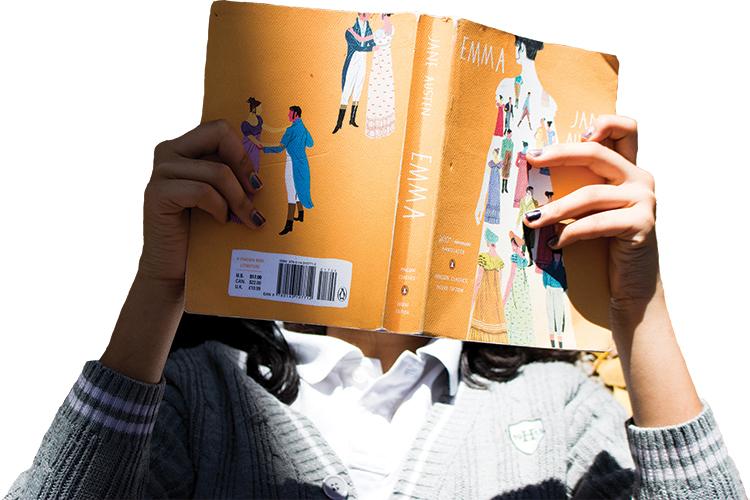Since 2012, Hockaday sophomores have accompanied British 19th century heroine Jane Eyre on her journey from the Reed household to Thornfield Manor as she endures the trials and tribulations that accompany the life of a young independent woman. However, this year current sophomores must say goodbye to the eponymous character of Charlotte Bronte?’s “Jane Eyre” and instead welcome Jane Austen’s Emma Woodhouse.
In order to bring a fresh change to the sophomore British literature course, the Hockaday English Department replaced “Jane Eyre” by Charlotte Bronte? with “Emma” by Jane Austen for the class of 2020.
“Jane Eyre” is known for its feminist values and the representation of a classic Gothic literature. The English Department originally chose this book for a classic British novel.
Jennifer McEachern, an Upper School English teacher who teaches two sophomore classes, thinks that “Jane Eyre” is a great book to look at the language and its plot.
“‘Jane Eyre” fits [the classic British novel] really well because it contains so many wonderful literary elements, and it also has a story that resonates young women about a girl growing up,” McEachern said.
Senior Shelby Schultz was impressed by Jane Eyre’s independent act.
“I think what I learned from [“Jane Eyre”] is that women don’t have to compromise. Don’t marry a man you don’t love; don’t feel content with poor treatment. Better yourself everyday and eventually you will get the love and treatment you deserve,” Schultz said.
Despite its pros, McEachern observed that the lengthy plot of “Jane Eyre” proved a challenge to many students.
Junior Maria Sailale read “Jane Eyre” during her sophomore class. She found herself struggling to relate to the book and at times found herself questioning Bronte’s feminism. She also agrees with McEachern about the length of the novel.
“Some parts were too descriptive and they went on a really long time,” Sailale said.
While Bilhartz and the other English faculty members recognized that many students struggled with the novel, they initially added the book to the sophomore curriculum to insert the voice of more female authors. Thus, when they decided to change the book, they wanted to ensure that the students would still have the opportunity to hear the voices of 19th century British women.
In order to change a book in a freshman, sophomore or junior English class, the faculty members who teach that grade level must convene and agree on the new selection. However, teachers have the ability to add supplemental texts, such as poems or short stories, but modifying core texts – the books mandated that all students of the same grade level must read such as “The Odyssey,” “The Canterbury Tales” and “The Great Gatsby” – requires a group consensus.
Last spring, sophomore English teachers held several meetings to discuss changing “Jane Eyre.” After examining numerous books, the faculty agreed upon Jane Austen’s “Emma,” another classic 19th century British novel. “Emma” shares many of the same themes as “Jane Eyre,” such as love, drama and the concept of Bildungsroman – a literary term for the maturation of a character – but the novel has a slightly more engaging plot, according to McEachern.
McEachern believes that “Emma” is a good replacement of “Jane Eyre” because the novel provides the perspective of a 19th century woman, a voice which is often overlooked in traditional English classes.
“Many 19th century British novels are written by men, and novels written by women bring in diversity in classes,” English teacher Jennifer McEachern said.
Many sophomores have also appreciated this change. Sophomore Lily Zhou enjoyed the book and appreciated the complexities of the characters.
Sophomore Cindy Pan agrees with Zhou’s interpretation of the novel.
“The depiction of the characters was in such a complex way. How the characters are intertwined carefully interested me,” Pan said.
But some students had a different opinion. For example, sophomore Jenny Choi found the plot pointless and inane.
“[“Emma”] is set in the midst of all historical background, war, and slave trade. And what Jane Austen is focusing about is one upper- class lady who just cares about the love life but she doesn’t have one. [The plot and Emma’s actions] were purposeless,” Choi said.
However, Bilhartz disagrees with this interpretation and asserts that “purposelessness” actually served a purpose: it was satire of British romance novels.
When choosing a replacement for “Jane Eyre,” the English Department considered the following factors: appropriateness, diversity, difficulty and theme.
While the Hockaday administration respects the decisions made by the English Department regarding the contents of the books, the English teachers try to keep the books appropriate to each grade level. Usually, freshman classes have more restrictions on explicit content than junior and senior classes, which read novels with some graphic scenes like those found in “Beloved” by Toni Morrison.
To keep the diversity of viewpoints, books are also added or taken out of the curriculum. For example, white males dominated the traditional canon, so in order to add a new perspective, the English Department decided to teach “A Mercy” by the contemporary African American writer Toni Morrison to the junior classes.
In Bilhartz’s opinion, a woman of color writing a story set in the 17th century differs from many other books that students have read, giving the students a chance to compare and contrast the novel to other works they read throughout the year like “The Scarlet Letter” written in 1850 by the American novelist Nathaniel Hawthorne.
“We can look at postmodern styles in America, women of color authors, history of 17th century America. We could do all kinds of things with [“A Mercy”],” Bilhartz said.
Furthermore, the English teachers want to create a broad connection between all books read in Upper School. Currently, sophomores experience the British hierarchical society by reading British literature, freshmen look at the complex globe in world literature and juniors relive the American Dream while studying American literature. Thus, the teachers ensure that all novels mesh with the overarching theme of the course.
And finally, the level of difficulty plays an important role in choosing the books. For example, the freshman English class began reading “The Tempest” during the 2014-2015 school year, but after the English faculty recognized that many students struggled with the difficulty of the play, the department decided to return to “The Midsummer Night’s Dream.”
Although the current sophomores may not have a chance to meet Jane Eyre, many have enjoyed cavorting with their new friend, Emma Woodhouse.
Story by Eugene Seong
Photo by Alexa May








